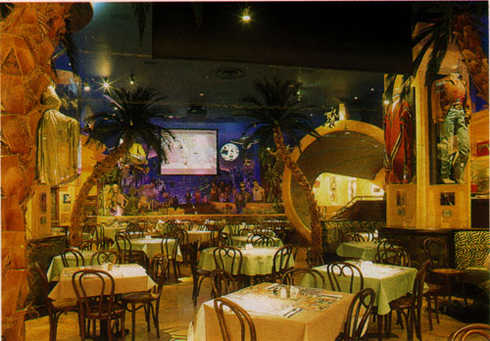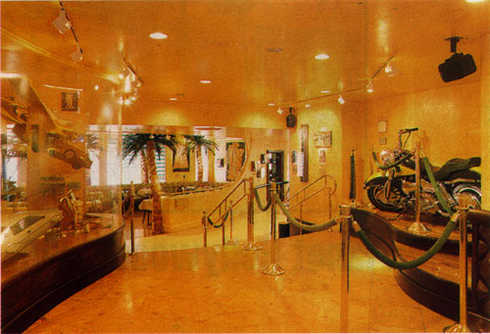Planet Hollywood London
By Kevin Hilton
May 1997
Burgers? Boring. Frozen yogurt? A yawn. Even old Mother Schwarzenegger's apple strudel doesn't tickle his taste buds. So why is Kevin Hilton queuing for a seat in London's glitziest new restaurant? Of course! It's the state-of-the-art sound-and-video system...
While we’ve all been keeping a close eye on the slow but sure merger of audio and visual technology in the living room, exciting things have been happening, too, in the world beyond the suburban semi.
Take, for example, the glitzy new burger bar, Planet Hollywood, owned by entrepreneur Robert Earl and film producer Keith Barish. Shrewdly, in launching their chain of star-spangled nosheries, these two main movers allowed most of the media attention to fall upon three minor (though spectacular be-muscled) shareholders, Sylvester Stallone, Arnold Schwarzenegger and Bruce Willis.
Since October 1991, the three hunks have been turning
up with their beautiful wives and friends to
open new branches, each time reducing city centers
to a pushing, shoving, screaming mass of popping
flashbulbs. The first human/instamatic gridlock
occurred in New York City, then came Costa Mesa
in California, and Cancun, Mexico. Last May,
Planet Hollywood mayhem hit London, and, in
July, Chicago. But even when there are no guaranteed
stars on view, the public have remained undeterred,
happy to queue for up to an hour for a chance
of glimpsing the costumes and movie memorabilia
which deck out the dining room, and, having
munched on a Sly burger or schlurped up a Terminator-sized
portion Arnie’s mom’s ‘home-made’ apple strudel,
they waddle somewhat uncomfortably towards the
exits, to queue again, to buy a souvenir Planet
Hollywood T-shirt or baseball cap.
 |
|
The main eating area, with the video screens lowered. |
For no matter how keen the management may be to emphasize the quality of the menu, people aren’t drawn to Planet Hollywood for the food. They come because, like EuroDisney or Jurassic Park, it’s late-20th-century ‘experience’. Come to Planet Hollywood and you can walk down Sunset Boulevard (or at least a tacky representation of it), eat nachos under the twinkling lights of the Hollywood Hills, gaze at Christopher Lee’s Dracula cape and marvel at Rambo’s discreet pocket knife, all the while being stirred by film-oriented music and occasionally shaken by film and video clips.
Installation and Innovation
As impressive as some of the movie memorabilia may be, it is the audio-visual installation that really drives Planet Hollywood along. It consists of a well-distributed stereo sound system and a series of remote controlled video screens, all operated from a control room using the latest computer software. Downstairs is a fully equipped THX preview theatre, available for private screenings and corporate presentations.
In charge of A/V design and technological innovation for the Planet Hollywood chain is Ted Rothstein, who has equipped four out of the five restaurants so far and acted as a consultant on the fifth. Rothstein is a veteran of the music recording and live sound touring scenes and brings his experience to bear when working on restaurants. As far as he’s concerned, there is no reason why you can’t have the same sound in the restaurant as in the recording studio where the music was originally created.
 |
|
Ted Rothstein |
Ted Rothstein’s and interesting fellow. Straight out of college he worked for Grumman Aircraft assisting the development of the power systems for the F1-11 fighter. Subsequently, he somehow found himself working at Media Sound in New York, the studio established by the producers of the legendary Woodstock Festival, and then followed a stint as chief engineer at Bearsville Studios in Woodstock, where he met guitarist-singer-songwriter-producer Todd Rundgren, for whom he designed a touring sound system. It was while he lived in Woodstock that Rothstein began to design to sound systems for a local club called The Joyous Lake. But it was when Rothstein was in Reykjavik, working on Iceland’s first 24-track studio that he first came across Hard Rock International, the company, then run by Robert Earl, which operates the world-famous Hard Rock Cafes. Rothstein, and his company, TR Technologies, subsequently got the contract to kit out 16 Hard Rocks around the world.
Now Ted Rothstein has a similar agreement with Earl and his Planet Hollywood ventures. There are obvious similarities between a Hard Rock Café and a Planet Hollywood – similarities that are, in fact, currently the subject of a $1 million law suit brought by Peter Morton, co-founder of the Hard Rock chain and owner of the cafes in the west of the US. Rothstein acknowledges that there is some common ground but says, ‘It’s the same kind of thing but with a different slant. They wanted a lot more video here; there isn’t really that much in the Hard Rocks. Sound is not as dominant in Planet Hollywood and it is a little more hidden than in the Hard Rocks.’
Music may not be as prominent but it is everywhere
and ever present. However, though you can identify
the tracks playing, you don’t have to shout
to be heard above the din by your companions.
Rothstein speaks of a ‘highly distributed array
of speakers’, which delivers stereo music to
the diners through a mixture of 40 wall mounted
JBL Control 1s and 132 adapted S-4s, JBL’s in-wall
speaker which has been mounted to the ceilings.
Extra depth comes from 16 cleverly hidden 4646A
12-inch sub-bass units.
 |
|
A corridor showing the JBL Control 1s bracketed to the ceiling. |
Mission Control
Versatility is the most important aspect of the installation. "We’ve got to be able to make these products do things that they were not supposed to do right out of the box," Rothstein observes. But when it comes down to it, the hardware is just hardware -- in the A/V market, it’s not what you use but what you do to it to make it work. "We’re heading towards much more fully automated systems," Rothstein explains. His work in this field now centers largely on the design of custom computer systems that can control the entire music output and run the screens and videos.
The computerized music system is able to change the music within given parameters, selecting and playing the right type of music within a given number of beats per minute at the right time of day. Source material is played on a 300-disc Pioneer CD player operated by Rothstein’s own control software, which gives read-outs of the tracks, both the one that’s playing and those to come. All possible parameters are shown, which can be changed by the DJ to suit the mood of the gathering or the time of day.
The DJ works in a rather cramped A/V control room, overseeing the automated music system and manually playing in film clips from either VHS video or LaserDisc. Eventually, there will be four LaserDisc machines and two VCRs, the intention to bring them under the same type of automation as the multi-play CD. The plan is to use a 50-LaserDisc caddy, controlled by similar software using the same sets of parameters. It is planned to install this in London at the end of the summer.
The nine video screens are likewise operated from the control room; a single box can either raise or lower all screens or trigger them individually. Also contained here are the various mixers, processors and matrixes, being a combination of proprietary units and those designed by TR Technologies. A separate rack room, fiendishly hidden behind the hat check counter, houses the power amplifiers, consisting of 11 MPA400s and one MPA600.
Supersonics
Despite the movie connection, only two of the five Planet Hollywoods, so far, have a preview theatre: New York and London. Rothstein worked on the sound system and video system design of the THX room in New York, using many of the techniques he has perfected as a designer of music recording studios to create an installation that pretty much set a new standard. Rothstein opines that the cinema trails behind music recording in audio quality by at least ten years, with the technology used in studios surpassing what is found in the theatres, even those that are THX.
Rothstein is convinced that a number of performance parameters must be met by the control room monitor systems so the producer, engineer, and musicians can listen accurately to the real mix that they’re laying down on to the master. In particular, the headroom is critical.
In New York, Rothstein created a switchable system that can produce both normal THX sound and something that comes as close to studio quality as possible, given the circumstances.
This obviously involved a lot of work and has not been repeated in London or elsewhere. For the UK Planet, Rothstein only worked on the video projection system. THX itself designed the London preview room, with equipment supplied by US company MTS (the majority of the equipment used in the A/V installation upstairs in the restaurant came from Harman Audio), with the installation carried out by South London-based Sound Associates.
The projectors, which can run both 35 and 70mm film, are made by Cinemeccanica and can operate with either optical or magnetic stock. Behind the screen there is the standard THX configuration of JBL 4675s; surround speakers are 8330s. Power comes from Crest amplifiers while the processor is the Dolby CP200, one of the most versatile on the market.
Planet Hollywood is a rare example of a high-end, high-cost marriage of sound and vision technologies. As such, it highlights what can be achieved in A/V when two disciplines that have attained quality in their own fields combine to set new standards. “My goal is to help bring it all together,” says Rothstein. “I’ve seen the cinema and the music worlds start to merge but there is a long way to go. Few of us cross the line between these industries and those of us that work in both find it frustrating that it doesn’t happen faster. As long as we keep trying to push high, though, it will eventually happen.”